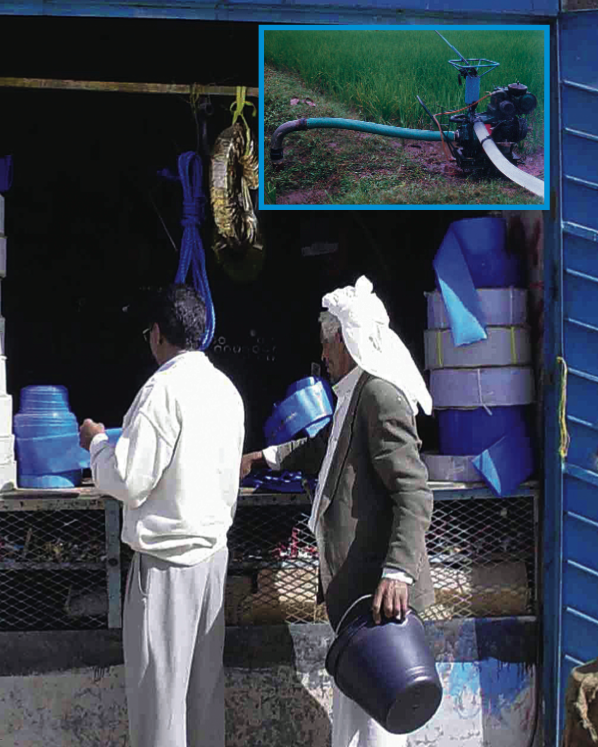Difference between revisions of "Irrigation - Lay flat hose"
(→Construction, operations and maintenance) |
(→Reference manuals, videos, and links) |
||
| Line 30: | Line 30: | ||
(Lay-flat hoses are also mentioned in the book in technology innovation and promotion in practice: pumps, channels and wells.) | (Lay-flat hoses are also mentioned in the book in technology innovation and promotion in practice: pumps, channels and wells.) | ||
* [ftp://ftp.fao.org/agl/aglw/docs/pressirrig.pdf TECHNICAL HANDBOOK ON PRESSURIZED IRRIGATION TECHNIQUES.] A. Phocaides, FAO. | * [ftp://ftp.fao.org/agl/aglw/docs/pressirrig.pdf TECHNICAL HANDBOOK ON PRESSURIZED IRRIGATION TECHNIQUES.] A. Phocaides, FAO. | ||
| + | * [http://www.siminet.org/images/pdfs/layflat-hoses.pdf Lay-flat hoses – self promoted micro-irrigation systems.] | ||
==Acknowledgements== | ==Acknowledgements== | ||
A. Phocaides. [ftp://ftp.fao.org/agl/aglw/docs/pressirrig.pdf TECHNICAL HANDBOOK ON PRESSURIZED IRRIGATION TECHNIQUES.] FAO. ROME, 2000. | A. Phocaides. [ftp://ftp.fao.org/agl/aglw/docs/pressirrig.pdf TECHNICAL HANDBOOK ON PRESSURIZED IRRIGATION TECHNIQUES.] FAO. ROME, 2000. | ||
Revision as of 01:41, 28 April 2012
| |
Irrigation sometimes involves transporting water over a long distance. Cement or clay canals are relatively costly, inflexible and cannot elevate water. PVC tubing or polypropylene (PP) hose is relatively expensive. In India, farmers started to use locally made plastic hose, called the lay-flat hose because the hose is flat when not in use. This hose is so cheap that even very low-income farmers can buy or rent it and irrigate their crops. It is often used for supplementary irrigation in unexpected dry periods in the rainy season. An additional advantage of lay-flat hose is that rolls are easy to transport and do not occupy valuable cropland as is the case with field channels.
Suitable conditions
| Advantages | Disadvantages/limitations |
|---|---|
| - Cheap to buy or rent. - Easy to transport. |
Construction, operations and maintenance
Layflat hose is made of soft PVC reinforced with interwoven polyester yarn. Layflat hoses are flexible, lightweight, and available in various sizes (millimetres or inches) from 1-6 in and for working pressures (PN) of 4.0-5.5 bars. They are manufactured with plain ends and supplied in coils in standard lengths of 25, 50 and 100 m.
There are no special connector fittings for layflat hoses. The hoses are connected by inserting small pieces of PE piping into the ends of the hoses, or by metallic quick couplings attached to both pipe ends. Small diameter PE tubes are used to connect laterals to the layflat manifolds. In these cases, wire ties are needed to secure the connections. However, several micro-irrigation industries have designed and manufactured special connector fittings for jointing their drip lines with layflat hoses.
They usually last one irrigation season only, as sunlight and movement of water make them brittle and they are easily punctured. They are made of recycled scrap, but can be resold as scrap too, at approximately 25% of their original price. The alternative is polyvinyl chloride tubes – which are more durable, but also two and half time the price and five times the weight. As a result they are less popular.
Costs
- Cost/100 m: (Yemen prices): US$ 20 - 30 (40 mm diameter), US$ 40 - 60 (80 mm diameter).
- The cost for a 100mm diameter tube in the Indian Terai is US$0.35/meter.
Field experiences
Reference manuals, videos, and links
(Lay-flat hoses are also mentioned in the book in technology innovation and promotion in practice: pumps, channels and wells.)
- TECHNICAL HANDBOOK ON PRESSURIZED IRRIGATION TECHNIQUES. A. Phocaides, FAO.
- Lay-flat hoses – self promoted micro-irrigation systems.
Acknowledgements
A. Phocaides. TECHNICAL HANDBOOK ON PRESSURIZED IRRIGATION TECHNIQUES. FAO. ROME, 2000.

